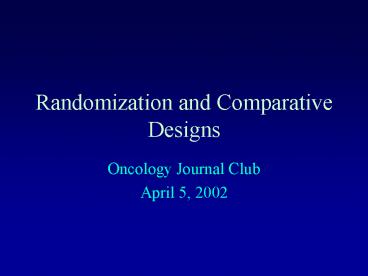Randomization and Comparative Designs PowerPoint PPT Presentation
Title: Randomization and Comparative Designs
1
Randomization and Comparative Designs
- Oncology Journal Club
- April 5, 2002
2
Comparative Designs
- Compare need more than one group
- Different types
- historical control
- two treatment groups
- treatment and placebo groups
- Phase III
3
Was this study comparative?
- What are the groups that are being compared?
- Treatment 1 vs. treatment 2?
- Was it randomized?
- What was were they randomized to?
- Did they show a difference in the two groups
under consideration? - Did they show that the groups being compared were
comparable with regard to pertinent factors?
4
Randomization
- Why? Whats the big deal?
- Reduces potential for bias
- Ensures that groups being compared are likely
to be similar to each other. - Example of violation of randomization bias
- selection bias the physician decides which
patients are assigned to which treatment - i.e. physician decides which patients get high
versus low radiotherapy!
5
Randomization
- What if physicians tend to give sicker patients
less radiotherapy? - Now, there is a correlation between being sick
and treatment. - Is it so strange to imagine that the sicker
patients would tend to have shorter survival? - Now that they have confounded sick status with
treatment, they CANNOT conclude anything about
treatment.
6
Randomization
- Idea of Confounders many variables may be
associated with outcome. By randomly assigning
individuals to treatment groups, we decrease
likelihood of making an error due to a confouding
variable
7
Randomization
- Randomization to low versus high radiotherapy
WOULD have made illness and treatment
independent. - How could this have been helped?
- Inclusion/exclusion criteria so that only kids
who were healthy enough could receive full dose - Stratify by stage ensure that comparable
numbers of sick and less sick kids are in each
arm.
8
Final Comments on Randomization
- It does not guarantee that groups are the same,
but the principle is that for large numbers of
patients, the groups will even out. - For small studies, might be a good idea to
stratify to really ensure balance. - Randomization isnt always truly random
- blocking
- stratification
9
Final Comments on Comparative Trials
- Selection bias not just physician choice
- center (e.g. multi-center study)
- patient (think about ITT vs. actual received)
- Blinding/Masking
- when possible, it is generally a good idea for
patient (blinded) or patient and physician
(double-blinded) to not know which group patient
is assigned to - avoids sub-concious effects
- avoids cross-over

